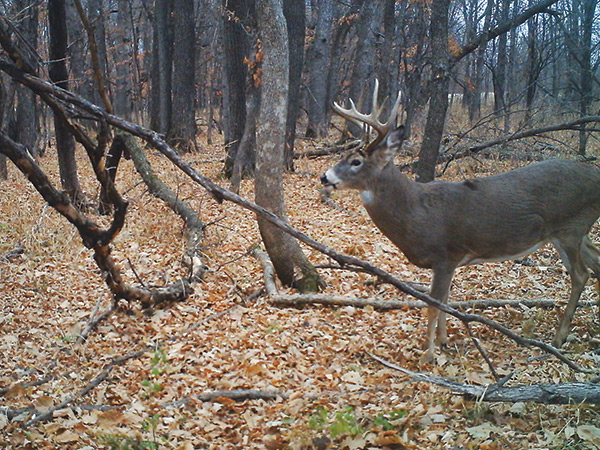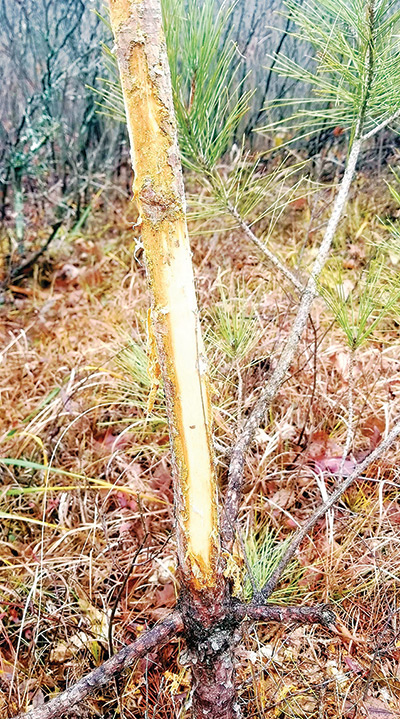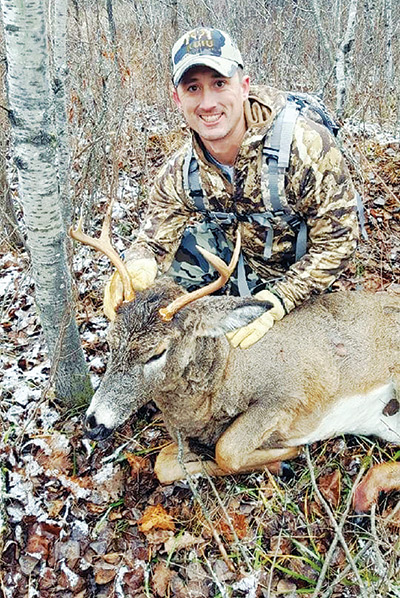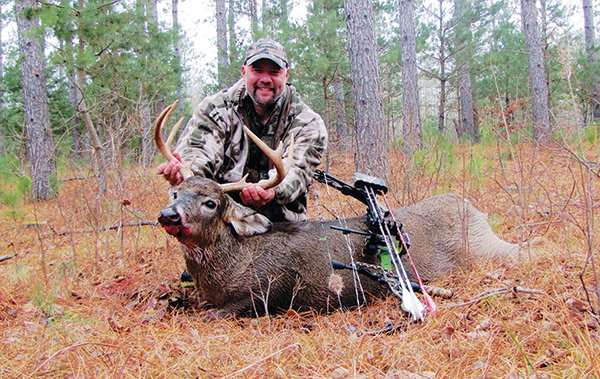 The Magic Deer-Hunting Temperature
The Magic Deer-Hunting Temperature
By Jeffrey Miller

Waiting patiently in darkness for daylight to creep over the eastern horizon, the morning’s still air felt pleasant on my face. Slowly, the woods began to glow with a soft light, and I started my watch for a rutting buck. With the sun came warmth, and by the time I lowered my bow from the stand several hours later, it was 60 degrees. I hadn’t seen a deer. Except for some foraging fox squirrels, the woods was way too quiet. In early November, 60 degrees was just too warm.
It’s no revelation that during the rut deer move more in cooler weather than during warm days. But is there a magic number that foreshadows good hunting?
Pursuing deer across the northern Great Plains and Midwest, my hunting buddies and I hope for 40 degrees.
For example, my first trip to northwestern Wisconsin occurred years ago during the first week of November. The timing worked great for my schedule, and I anticipated bucks chasing does. However, the weather was beautiful Indian summer – golden, sunny days followed by tepid nights. While hunting buddy Ryan Sura harvested a beautiful eight pointer, Andy Dahn and I saw few deer. I took a nice doe, but only saw one small buck.
We were lamenting the slow movement over dinner with friend and landowner Mark Smith, an experienced hunter and outdoorsman who has lived in the area his entire life. He mentioned that daytime highs of 40 degrees, or slightly lower, is when he saw the most buck movement. Even with that information, it took a few years for it to sink in.
We continued to hunt the first full week of November for a couple more years. Occasionally the weather worked in our favor. I shot a big-bodied six-point one chilly evening, and Andy wrapped his tag around a couple fine bucks as well. Nonetheless, the following week was always cooler, and Mark reported seeing bucks each morning on his trapline.
A local hunt in North Dakota finally convinced me of the magic of 40 degrees.
Perched in an ash tree stand in a riparian area, I was hunting a funnel that had produced deer in the past. It was the day before Halloween, and daytime temperatures hovered in the upper 30s. With a forecast high of 41 degrees and a gentle west wind, I took the day off work.
As daylight filtered into that river bottom, I immediately noticed a scrape line, directly following the trail I was watching. Much scraping activity occurs after darkness falls, but enough happens during the day that I don’t feel confident during the early parts of the rut unless I’m near some scrapes.

Across the river I watched three bucks sparring, one of which was a giant eight-point. After they wandered off, the unmistakable cadence of deer moving drew my attention south, where I spied a pair of bucks heading my way. The smaller, a fork-horn, drifted to the west, slipping through a prickly ash patch. The larger, a deep-chested nine-point, followed the script perfectly. After checking a few scrapes, he paused in my shooting lane at 19 yards. As soon as my arrow sliced through his chest, he bounded away, crashing to the ground in less than 100 yards. It turned out to be a memorable morning indeed.
Soon after that, we moved our annual Wisconsin bow camp dates back a week and began enjoying more success. Andy, Ryan, and Pat Swenson hung butterball fat bucks on the meat pole each year, and each reported seeing more deer than ever before.
This past fall was a perfect example of scheduling a hunt around the right conditions. I hunted near home the first week of November, only seeing a small five-point. With daytime temperatures in the 60s, it was perfect for yard and garden work, but not for tagging a buck.
Fortunately, the next week looked more favorable. The forecast for northwestern Wisconsin called for lows in the 20s and highs in the upper 30s and low 40s. The only sticky wicket was rain in the forecast. Driving east, I hoped against hope the rain would miss the area.
That first evening was windy and drizzly. The few deer I saw were jumpy and alert. A tiny spike attempted to chase a mature doe through the food plot, clearing the area. I checked my phone, saw a text from Andy. He’d hit a buck and was waiting a few minutes to take up the trail. Tired of being cold and wet, with no deer around my stand, I hustled over to help him track.
He was only 10 minutes away, but I wasn’t even to his stand when he texted again, this time with a photo of a gorgeous eight-point buck. I arrived in time to take some pictures and help him drag the buck out to his pickup.
Seems the deer were jumpy at his stand as well. As some does fed in front of him, Andy noticed their attention shifting to the oak brush to the east. The eight-point popped out in a small food plot and trotted directly into the group of does. Andy admitted he was nervous, with a buck standing less than 20 yards from his stand and the wind swirling. Seizing the first shot opportunity, he leveled his crossbow and placed a bolt into the buck’s chest. The does scattered. The buck bounded to the end of the shooting lane, then, after a moment of rest, leapt into the brush. Andy sat still, with only the sound of falling rain to keep him company.
Worried about the blood trail washing away, he went directly to the last place he had seen the deer after a 10-minute wait. There, in the thick, wet brush lay the buck.

The next day was a complete wash out. It rained dawn to dusk, sometimes sprinkling, sometimes pouring. As much as Pat and I hated sitting out a day of hunting, it just didn’t make sense to hunt in the rain. Knowing we both had scrapes by our stands, however, made anticipating the next morning nearly unbearable.
Overnight, the rain quit. Temperatures were to be a steady 40 degrees. Slipping down the hill to my stand overlooking the food plot before daylight that morning, my boots tracked silent over wet ground.
The sun did not simply rise on that chilly, overcast day; it slowly bled across the land. And as soon as I could see the ground, I watched a small doe enter the food plot. Since I had both buck and doe tags, I eased into position, hoping a bigger deer was nearby.
Fifteen minutes later, a large grey doe trotted in. As she began to feed a touch more than 20 yards from my tree stand in a red pine, I eased my bow to full draw. The arrow flickered through the murky light, passing completely through the deer. She charged off into the brush, the sounds of her hoof beats receding into the distance. The shot looked good, but I had a bad feeling about how far she had run. I decided to give her at least two hours before tracking.
It wasn’t long before another pair of does ambled in. The doe and fawn began grazing, oblivious to the arrow and its lighted green nock stuck into the ground. After some time, both deer jerked their heads looking south, towards a patch of planted red pines. I heard the unmistakable grunt of a rutting buck floating through the quiet air.
I expected to see the amorous spike of the first night, but nearly fell out of the tree when a burly eight-point trotted into the open. He was by far the largest buck I’d encountered in the sand country of northwestern Wisconsin. My heart began pounding in my ears and my knees started to shake.
The buck shook water off his coat like an overgrown Labrador and hurried towards the mature doe. Lifting his head, he curled his nose searching for the scent of an estrous doe. The doe flickered off to my right, and the buck presented a broadside shot at 22 yards.
My wobbly arms brought my bow to full draw. The top pin settled on his chest, and the arrow drove deep directly above his leg into the sweet spot of the lungs. Running low to the ground, the big buck tore back into the pines. A tremendous crash let me know he didn’t go very far.
Minutes later I was standing over my largest Wisconsin buck in 13 years of hunting that wonderful state. After photos and field dressing, I began trailing the doe.
Unfortunately, as I had suspected, the trail was much longer than it should have been. Rather than charging ahead on a spotty trail, I called Andy for back up. He and his father, Rick, soon met me at the food plot and we spread out from last blood, deep into the cover. Andy is a like a bloodhound on a deer trail, and soon we were standing over my big doe. Hit through the liver and one lung, she had made 300 yards before bedding and expiring on the riverbank. It was an unforgettable hunt, made possible by the perfect temperature for deer movement.
Deer hunting has a myriad of variables, some that hunters can control, some they can’t. After more than 26 years of bowhunting and taking advice from great hunters like Mark and Andy, I watch the weather forecast even closer once the end of October rolls around. While it’s no guarantee of success, hunting when daytime highs are around 40 degrees puts the hunter in a fighting position to fill a buck tag and place yet another lifelong adventure into the memory bank.
